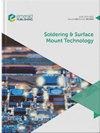时效对无铅钎料合金组织和硬度的影响
IF 1.8
4区 材料科学
Q3 ENGINEERING, ELECTRICAL & ELECTRONIC
引用次数: 1
摘要
目的研究Sn-Cu-Ag合金在铸态和不同温度(100ºC和180ºC)人工等温时效下500 h的显微组织和显微硬度的变化,并与Sn-37% Pb共晶焊料样品进行比较。浇注Sn-0.7%Cu和Sn-3.5%Ag-0.9%Cu,分别在100℃(373ºK)和180℃(453ºK)下时效500 h。通过光学显微镜、扫描电镜和能量色散x射线显微分析观察组织结构变化。用差示扫描量热法(DSC)对所得结果进行了验证。结果发现,在两种时效温度下,合金的显微硬度相对于铸态合金的硬度降低了20%。这些变化可以解释为所有研究体系的微观结构中存在的锡枝晶的粗化和再结晶。原创性/价值在研究温度范围内,没有证据表明可以通过DSC量热技术检测到新相的溶解或沉淀。其作用机制可能是等温时效初期锡枝晶粗化和残余应力松弛的结果。本文章由计算机程序翻译,如有差异,请以英文原文为准。
Influence of aging on microstructure and hardness of lead-free solder alloys
Purpose
The purpose of this paper is to carry out a study of the evolution of the microstructure and the microhardness of Sn-Cu-Ag alloys from as-cast condition and under artificial isothermal aging at different temperatures (100ºC and 180ºC) for a treatment time up to 500 h. A comparison with Sn-37% Pb eutectic solder samples was also made.
Design/methodology/approach
Sn-3.5%Ag, Sn-0.7%Cu and Sn-3.5%Ag-0.9%Cu were poured in two different cooling rate conditions and then aged at 100ºC (373ºK) and 180 °C (453ºK) during 500 h. Microstructural changes were observed by optical microscopy, scanning electron micrograph and energy dispersive X-ray microanalysis. Differential scanning calorimetry technique (DSC) was also used to confirm the obtained results.
Findings
A decrease up to 20% in microhardness respect to the value of the as-cast alloy was observed for both aging temperatures. These changes can be explained considering the coarsening and recrystallization of Sn dendrites present in the microstructures of all the systems studied.
Originality/value
There is no evidence of dissolution or precipitation of new phases in the range of studied temperatures that could be detected by DSC calorimetry technique. The acting mechanisms must be the result of coarsening of Sn dendrites and the residual stresses relaxation during the first stages of the isothermal aging.
求助全文
通过发布文献求助,成功后即可免费获取论文全文。
去求助
来源期刊

Soldering & Surface Mount Technology
工程技术-材料科学:综合
CiteScore
4.10
自引率
15.00%
发文量
30
审稿时长
>12 weeks
期刊介绍:
Soldering & Surface Mount Technology seeks to make an important contribution to the advancement of research and application within the technical body of knowledge and expertise in this vital area. Soldering & Surface Mount Technology compliments its sister publications; Circuit World and Microelectronics International.
The journal covers all aspects of SMT from alloys, pastes and fluxes, to reliability and environmental effects, and is currently providing an important dissemination route for new knowledge on lead-free solders and processes. The journal comprises a multidisciplinary study of the key materials and technologies used to assemble state of the art functional electronic devices. The key focus is on assembling devices and interconnecting components via soldering, whilst also embracing a broad range of related approaches.
 求助内容:
求助内容: 应助结果提醒方式:
应助结果提醒方式:


